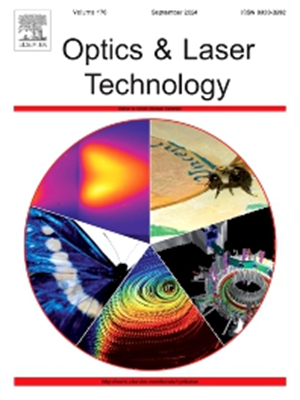Quasi-bound states in the continuum induced via surface roughness
IF 5
2区 物理与天体物理
Q1 OPTICS
引用次数: 0
Abstract
Regular structural perturbations have been widely introduced into optical metasurfaces to break their symmetry and excite quasi-bound states in the continuum (BICs), which possess a high-quality factor. Here, we investigate how the irregular roughness of 1D metasurfaces influences the disruption of structural symmetry and impacts the excitation of quasi-BIC. First, random roughness is introduced on the sidewalls of a 1D grating constituting a metasurface. Then, the excited resonance of a rough metasurface is compared with the quasi-BIC of a metasurface possessing regular asymmetry with a flat sidewall to verify that the excited resonance is due to the quasi-BIC. Furthermore, the influence of degree of roughness is examined by analyzing the resonance wavelength and the excited field intensity. As the roughness increases, the resonance wavelength distribution broadens toward longer wavelengths, and the largest field intensity increases, although lower intensities dominate overall. Second, the distribution of resonance wavelengths and the range of maximum field intensities are analyzed with an increase in the number of gratings with independent rough profiles in a super-cell. As additional gratings are incorporated into the super-cell, the resonance wavelength distribution converges to the true BIC wavelength. At the same time, the range of maximum field intensity gradually decreases. Last, we investigate rough metasurfaces covered with a homogeneous high-refractive-index layer and confirm the excitation of two quasi-BICs having opposite parities.

表面粗糙度引起的连续介质中的准束缚态
规则结构摄动被广泛地引入光学超表面,以打破其对称性并激发具有高质量因子的连续介质中的准束缚态。在此,我们研究了一维超表面的不规则粗糙度如何影响结构对称性的破坏和准bic的激发。首先,在构成超表面的一维光栅侧壁上引入随机粗糙度。然后,将粗糙超表面的激发共振与具有平坦侧壁的规则不对称超表面的准bic进行比较,验证了激发共振是由准bic引起的。此外,通过分析共振波长和激发场强度,考察了粗糙度的影响。随着粗糙度的增加,共振波长分布向较长波方向变宽,最大场强增加,但总体上以较低场强为主。其次,分析了在超级电池中,随着具有独立粗糙轮廓的光栅数目的增加,共振波长的分布和最大场强的范围。由于在超级电池中加入了额外的光栅,共振波长分布收敛到真正的BIC波长。同时,最大场强范围逐渐减小。最后,我们研究了覆盖均匀高折射率层的粗糙超表面,并证实了两个具有相反奇偶的准bic的激发。
本文章由计算机程序翻译,如有差异,请以英文原文为准。
求助全文
约1分钟内获得全文
求助全文
来源期刊
CiteScore
8.50
自引率
10.00%
发文量
1060
审稿时长
3.4 months
期刊介绍:
Optics & Laser Technology aims to provide a vehicle for the publication of a broad range of high quality research and review papers in those fields of scientific and engineering research appertaining to the development and application of the technology of optics and lasers. Papers describing original work in these areas are submitted to rigorous refereeing prior to acceptance for publication.
The scope of Optics & Laser Technology encompasses, but is not restricted to, the following areas:
•development in all types of lasers
•developments in optoelectronic devices and photonics
•developments in new photonics and optical concepts
•developments in conventional optics, optical instruments and components
•techniques of optical metrology, including interferometry and optical fibre sensors
•LIDAR and other non-contact optical measurement techniques, including optical methods in heat and fluid flow
•applications of lasers to materials processing, optical NDT display (including holography) and optical communication
•research and development in the field of laser safety including studies of hazards resulting from the applications of lasers (laser safety, hazards of laser fume)
•developments in optical computing and optical information processing
•developments in new optical materials
•developments in new optical characterization methods and techniques
•developments in quantum optics
•developments in light assisted micro and nanofabrication methods and techniques
•developments in nanophotonics and biophotonics
•developments in imaging processing and systems

 求助内容:
求助内容: 应助结果提醒方式:
应助结果提醒方式:


